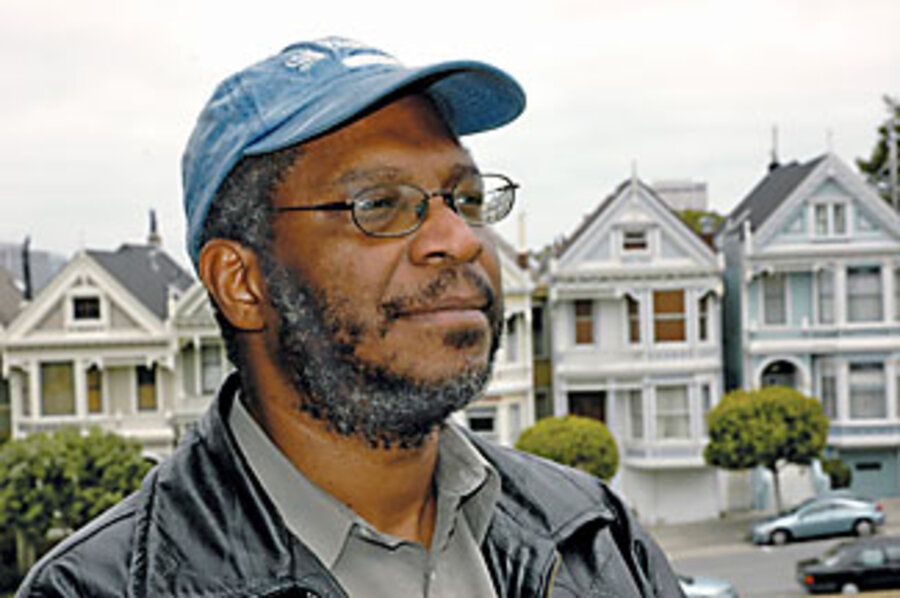Blacks abandon San Francisco
Loading...
| San Francisco
On a recent overcast Saturday, just before noon, the ministers from some of this city's largest black churches arrived in their dapper and dark suits, looking somewhat out of place on a dusty construction site.
They had come to break ground on 21 affordable apartments – a joint project between a church-affiliated development group and Kaiser Permanente, the healthcare provider. There were photo ops, the ceremonial shovels of dirt, and, given the number of reverends on hand, plenty of prayers.
This neighborhood, known as the Western Addition, was once the heartbeat of San Francisco's African-American community. Fillmore Street, known for its vibrant postwar jazz scene, is a few blocks away. KPOO, the first black-owned noncommercial radio station west of the Mississippi, is up the street. And the ministers say they hope that these new apartments – albeit not solely for black residents – begin to stem the rapid decline of the city's African-American population.
Blacks have been leaving San Francisco in record numbers. Blacks accounted for 6.5 percent of the population in 2005, down from a high of 13.4 percent in 1970 – the steepest decline of any major US city, according to the US Census Bureau.
While San Francisco's image has been defined by a history of tolerance and openness, some say today's reality is much different. They paint a picture of a racially and economically divided city where blacks are vanishing from the social and cultural fabric, priced out and marginalized by the urban redevelopment policies of the past half century.
The decline in the black population has been so rapid that Mayor Gavin Newsom launched the African American Out-Migration Task Force and Advisory Committee in 2007 to reverse the trend. One key recommendation of the committee is for more affordable housing – much like the new development in the Western Addition.
It's projects like this, says the Rev. J. Edgar Boyd of Bethel African Methodist Episcopal Church, that could help retain middle-class African-Americans who may otherwise flee to northern California cities such as Stockton or Antioch. That flight has left a wide gulf within the black community here. On one end of the spectrum, seniors stay because they own homes. On the other, poorer and younger black families populate public housing. What's missing, he says, is a middle ground.
That means fewer churchgoers in the pews on Sundays and not as many parishioners taking part in community efforts. "It just kills the life and spirit of the community," he says.
Findings of the mayor's task force confirm that black families with moderate and above-moderate incomes have been leaving since 1990. As a result, very-low-income households made up more than two-thirds of the black population in 2005 – up from roughly one-half in 1990.
The task force also said that the per capita income for African-Americans here is 56 percent less than that of whites. Blacks "lag behind the rest of the city in almost every key economic indicator and face significant barriers to addressing the disparities," it said.
The absence of middle-class blacks in San Francisco leaves the impression that "we are not stakeholders in the community," says Pastor Boyd.
"A lot of African-American people feel that way," says Fred Blackwell, executive director of the San Francisco Redevelopment Agency, echoing the task force's conclusion that many black San Franciscans feel increasingly disconnected with the city.
That was true for Rachel Satterfield, the child of an African-American father and Puerto Rican mother, who came to San Francisco three years ago searching for the diversity her hometown in Alaska never had.
Now, the 20-something hipster with a burst of dark curly hair has found people like her – but only after leaving San Francisco. She has moved across the San Francisco Bay to Oakland. "That's what I was expecting to find when I moved to San Francisco," she says.
The decline of the black community began decades ago, many say, long before the dotcom boom and the housing bubble pushed housing to a peak median price of $665,000 in 2007.
During a massive redevelopment of Western Addition between 1958 and 1971, hundreds of homes owned by black residents were torn down and businesses razed. Public housing tracts replaced blocks of the large Victorians – houses that may have been dilapidated at the time but would be valuable now.
What's more, the transformation of San Francisco's economy has been a key factor. Closure of the city's shipyard in the early 1970s caused many blacks to leave for jobs elsewhere in the Bay Area and to move out of the Bay View-Hunters Point neighborhood. As San Francisco's economy moved away from manufacturing, activists say, blacks were left out of the new service economy.
But the out-migration of blacks from San Francisco has positive aspects, too. An "increase in economic status has enabled many African-American homeowners to sell their houses and take the profits to the suburbs," states a study by San Francisco State University's College of Ethnic Studies and its Public Research Institution.
For John William Templeton, author and black historian, there's no choice: He's smitten with San Francisco even though he says blacks are being "excluded from the heritage and the economy."
"Everybody in the world is trying to get to San Francisco, but black folks are leaving. What's up with that? It's because they don't see a future," he says. •





